From snowy winters and midnight sun summers to unpredictable rain showers, here’s how the seasons shape the weather and life in Norway’s Arctic city.
Whether you’re visiting Tromsø to chase the northern lights, experience Arctic nature, or enjoy the magic of the midnight sun, one thing is certain: packing appropriately is essential.
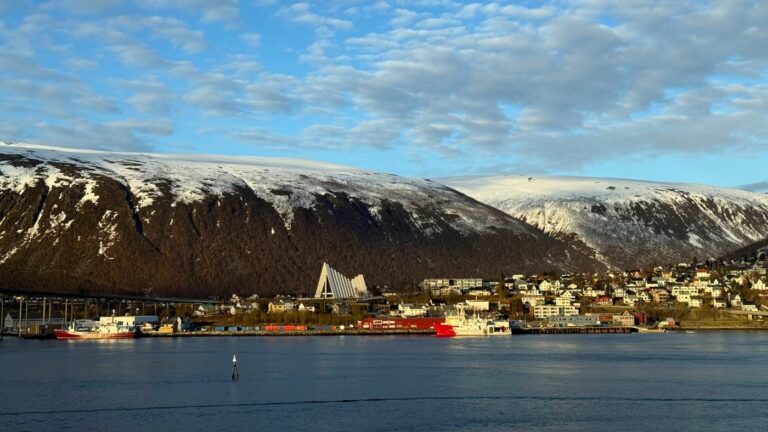
The weather in Tromsø is famously unpredictable, with rapidly changing conditions and a climate quite unlike elsewhere in Europe. Understanding what to expect in each season will help you prepare for your adventure north of the Arctic Circle.
An Overview of the Tromsø Climate
Tromsø sits at 69.4°N, far above the Arctic Circle. Yet despite its latitude, the city’s coastal location gives it a surprisingly mild climate compared to other places so far north.
This is due to the warm ocean currents of the Norwegian Sea and prevailing westerly winds, which help moderate temperatures throughout the year.
Although Tromsø has a boreal or subarctic climate, its winters are not as extreme as many assume. Average temperatures in the coldest months tend to hover just below freezing, while summers are cool and relatively short.
Precipitation is fairly consistent year-round, although autumn is typically the wettest season. Snowfall is common in winter, and snow cover tends to persist for several months.
Outside the city, especially at higher altitudes, the climate shifts to alpine tundra, with colder conditions and more snowfall.
Tromsø Weather: Season by Season
The weather this far north is partly influenced by the behaviour of the sun. During the height of the summer, the sun never sets in Tromsø, a time known as the midnight sun.
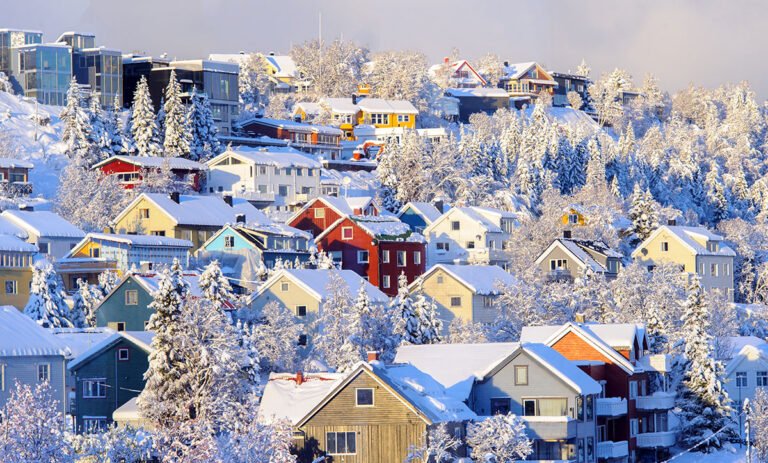
In the winter, the opposite happens. For a few weeks either side of late December, the sun doesn't rise. While it's not completely dark, this time is known as the polar night.
Autumn and Early Winter (September to December)
Autumn arrives early in Tromsø. By September, temperatures begin to fall rapidly, and the first snow can appear at any time from mid to late October.
This season is also the wettest, with October typically recording the highest monthly rainfall. Rain showers are frequent in September and October, but snow becomes more likely as winter approaches.
Temperatures in early autumn often reach around 7–8°C, but by December, the average is well below freezing. The days grow rapidly shorter, and by late November, the sun no longer rises above the horizon.
This marks the beginning of the polar night, a period of twilight and darkness that lasts until mid-January.
Winter and Polar Night (December to March)
The polar night is a defining feature of winter in Tromsø. Although it may sound bleak, the weeks of twilight create a unique, blue-tinged atmosphere, and the long nights offer the perfect backdrop for viewing the northern lights.
In fact, the often clear winter nights in February and March are considered the best time of year for aurora sightings.
Despite its Arctic location, Tromsø’s winter temperatures are relatively moderate, thanks to its coastal influence. Daytime highs typically range from −2°C to −4°C, with night-time lows dipping to −6°C or lower.
Snowfall is frequent, and snow often covers the ground from November through April. January is usually the coldest month of the year.

While cloud cover is common, especially in early winter, clearer skies become more frequent later in the season. This combination of cold temperatures and longer nights makes late winter a popular time for visitors hoping to see the aurora borealis.
Spring (March to May)
Spring arrives slowly in Tromsø. In March, daytime temperatures often remain around freezing, and snow is still very much part of daily life. This continues through early April, when the increasing strength of the sun and rapidly lengthening days begin to melt the snow in lower-lying areas.
By late April, the streets of Tromsø are usually clear, although patches of snow may linger in shaded areas and higher ground.
May brings a more dramatic shift in both temperature and appearance, with average highs climbing above 10°C and the landscape gradually turning green. Norwegian Constitution Day in mid-May could see snow, bright sunshine, or both.
Snow is less common in May and virtually unheard of in June, which begins to resemble summer even if the temperatures remain relatively cool. Rainfall during spring is still common, but generally lighter and less frequent than in the autumn.
Spring offers a rewarding mix of changing light and landscape. March and early April are perfect for enjoying winter activities with more daylight, while May and June reveal a softer, greener side of northern Norway ideal for photography and scenic walks.
Summer and Midnight Sun (June to August)
Summer in Tromsø is a time of light, celebration, and surprisingly cool temperatures. From around 19 May to 27 July, the sun doesn’t set at all.
This phenomenon, known as the midnight sun, allows for 24-hour daylight and endless opportunities for hiking, sightseeing, and soaking up the region’s natural beauty.
Despite the constant light, temperatures remain modest. July is typically the warmest month, with daily highs averaging around 12–13°C. That said, warm spells can push temperatures into the low 20s, and rare heatwaves have brought highs of up to 30°C.
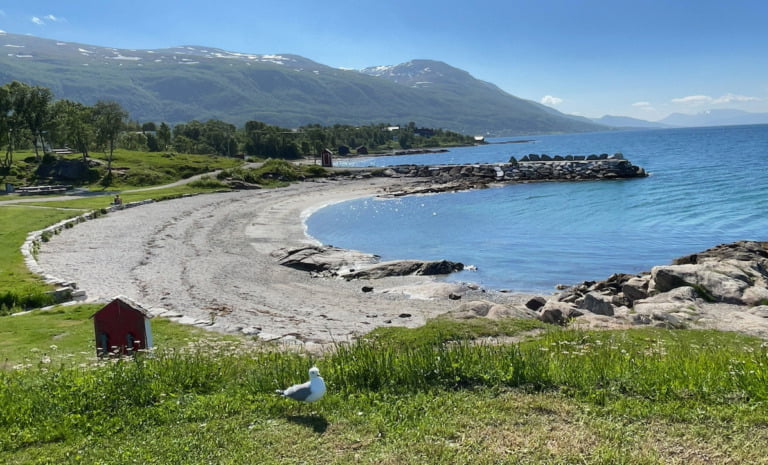
June is often the driest and clearest month, although rain remains a possibility at any time of year. Even during summer, it’s wise to pack for variable weather, including waterproof clothing and an extra layer or two for chilly evenings.
Wind and Coastal Weather
Tromsø’s location on the coast of Northern Norway means it is frequently exposed to rapidly changing weather conditions, particularly in the shoulder seasons.
Autumn and early winter are especially prone to powerful low-pressure systems sweeping in from the Atlantic. These systems can bring strong winds, heavy rainfall, sleet, and dramatic temperature swings, all in a single day.
Stormy weather is not uncommon from October through December, and wind gusts can sometimes reach storm-force levels. While snow and freezing temperatures dominate in winter, it’s the wind that often catches visitors off guard, especially when combined with icy surfaces or blowing snow.
Travellers planning boat excursions, island hopping, or wildlife safaris should always check the latest marine weather forecasts, as ferries and tours may be delayed or cancelled with little notice.
Even in summer, coastal breezes can be brisk, especially in the evening or on the water. A windproof outer layer is a must year-round, whether you're standing on a mountaintop or waiting for the northern lights by the fjord.
Daylight Through the Year
Perhaps the most striking feature of life in Tromsø is the dramatic variation in daylight. From late November to mid-January, the sun never rises above the horizon. The extra dark hours make it a great time for northern lights tours.
This period, however, is not completely dark. There are several hours of soft blue twilight each day, but the lack of direct sunlight has a profound impact on the rhythm of daily life.
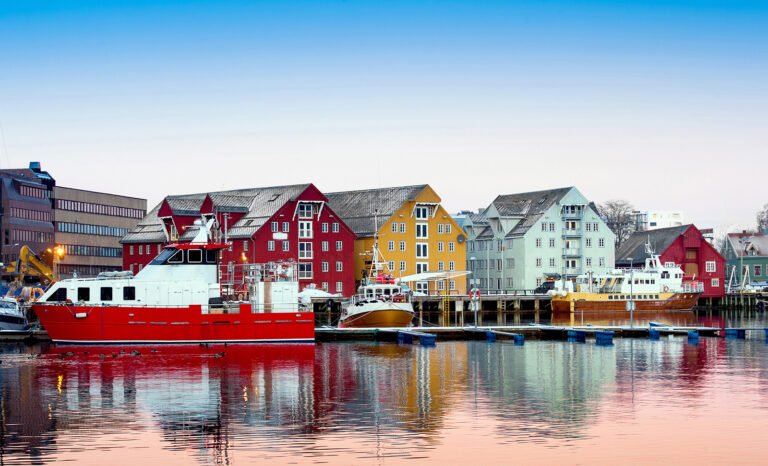
In contrast, the midnight sun dominates from mid-May to late July, with continuous daylight offering energy and freedom to explore around the clock. The sun never sets during this time, even in the middle of the night, creating a surreal and often energising atmosphere.
These extremes in light can affect everything from wildlife migration patterns to human sleep cycles. Many locals use daylight lamps or prioritise outdoor activity in winter to help offset the lack of sunlight, while black-out blinds become essential during the peak of summer.
For visitors, adjusting to the polar night or midnight sun can take a few days, but both experiences offer a unique and unforgettable insight into life in the Arctic.
What to Pack and Wear
No matter when you visit Tromsø, you should come prepared for changeable weather. Rain and wind can appear with little warning, and temperatures can swing noticeably throughout the day.
The key to staying comfortable is to dress in layers, allowing you to add or remove clothing as needed.
In winter, a heavy insulated jacket, thermal underwear, wool layers, and waterproof outerwear are essential. Don’t forget a hat, gloves, scarf, and appropriate footwear, ideally with good grip for icy surfaces.
In summer, you can get by with lighter clothing, but you’ll still need a fleece or jumper and a windproof jacket, especially if you plan to head into the mountains or go out late at night.
Sunglasses and sunscreen are surprisingly useful, especially during the midnight sun season, when the low-angled sun can still be intense.

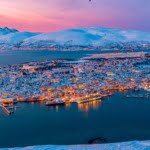

What format are your pictures? I can only view about a third of them.